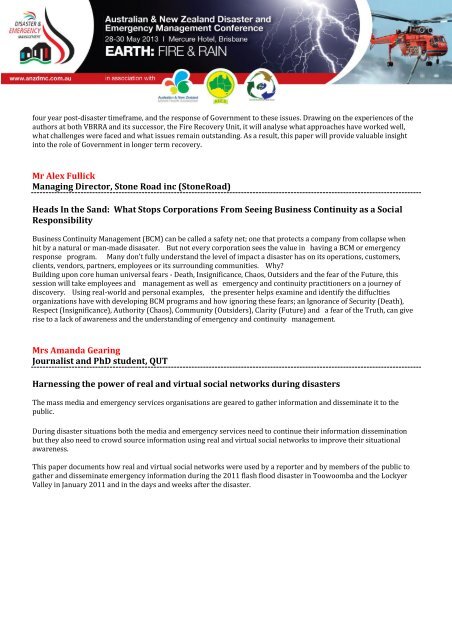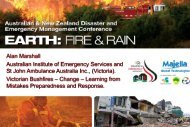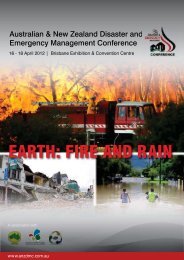Book of Abstracts 2013 - Australian and New Zealand Disaster ...
Book of Abstracts 2013 - Australian and New Zealand Disaster ...
Book of Abstracts 2013 - Australian and New Zealand Disaster ...
Create successful ePaper yourself
Turn your PDF publications into a flip-book with our unique Google optimized e-Paper software.
four year post-disaster timeframe, <strong>and</strong> the response <strong>of</strong> Government to these issues. Drawing on the experiences <strong>of</strong> the<br />
authors at both VBRRA <strong>and</strong> its successor, the Fire Recovery Unit, it will analyse what approaches have worked well,<br />
what challenges were faced <strong>and</strong> what issues remain outst<strong>and</strong>ing. As a result, this paper will provide valuable insight<br />
into the role <strong>of</strong> Government in longer term recovery.<br />
Mr Alex Fullick<br />
Managing Director, Stone Road inc (StoneRoad)<br />
Heads In the S<strong>and</strong>: What Stops Corporations From Seeing Business Continuity as a Social<br />
Responsibility<br />
Business Continuity Management (BCM) can be called a safety net; one that protects a company from collapse when<br />
hit by a natural or man-made disasater. But not every corporation sees the value in having a BCM or emergency<br />
response program. Many don't fully underst<strong>and</strong> the level <strong>of</strong> impact a disaster has on its operations, customers,<br />
clients, vendors, partners, employees or its surrounding communities. Why?<br />
Building upon core human universal fears - Death, Insignificance, Chaos, Outsiders <strong>and</strong> the fear <strong>of</strong> the Future, this<br />
session will take employees <strong>and</strong> management as well as emergency <strong>and</strong> continuity practitioners on a journey <strong>of</strong><br />
discovery. Using real-world <strong>and</strong> personal examples, the presenter helps examine <strong>and</strong> identify the diffuclties<br />
organizations have with developing BCM programs <strong>and</strong> how ignoring these fears; an Ignorance <strong>of</strong> Security (Death),<br />
Respect (Insignificance), Authority (Chaos), Community (Outsiders), Clarity (Future) <strong>and</strong> a fear <strong>of</strong> the Truth, can give<br />
rise to a lack <strong>of</strong> awareness <strong>and</strong> the underst<strong>and</strong>ing <strong>of</strong> emergency <strong>and</strong> continuity management.<br />
Mrs Am<strong>and</strong>a Gearing<br />
Journalist <strong>and</strong> PhD student, QUT<br />
Harnessing the power <strong>of</strong> real <strong>and</strong> virtual social networks during disasters<br />
The mass media <strong>and</strong> emergency services organisations are geared to gather information <strong>and</strong> disseminate it to the<br />
public.<br />
During disaster situations both the media <strong>and</strong> emergency services need to continue their information dissemination<br />
but they also need to crowd source information using real <strong>and</strong> virtual social networks to improve their situational<br />
awareness.<br />
This paper documents how real <strong>and</strong> virtual social networks were used by a reporter <strong>and</strong> by members <strong>of</strong> the public to<br />
gather <strong>and</strong> disseminate emergency information during the 2011 flash flood disaster in Toowoomba <strong>and</strong> the Lockyer<br />
Valley in January 2011 <strong>and</strong> in the days <strong>and</strong> weeks after the disaster.






